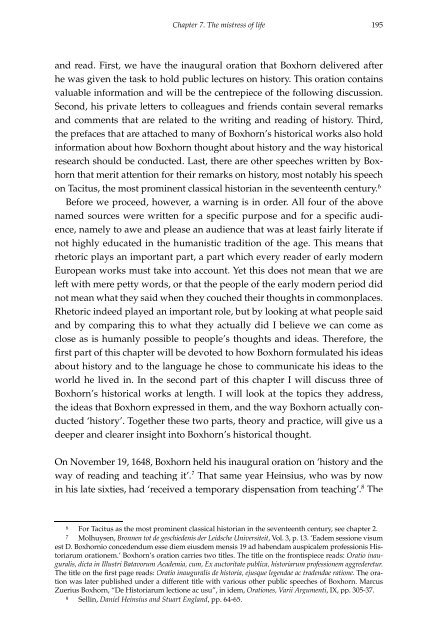historical and political thought in the seventeenth - RePub - Erasmus ...
historical and political thought in the seventeenth - RePub - Erasmus ...
historical and political thought in the seventeenth - RePub - Erasmus ...
You also want an ePaper? Increase the reach of your titles
YUMPU automatically turns print PDFs into web optimized ePapers that Google loves.
Chapter 7. The mistress of life<br />
<strong>and</strong> read. First, we have <strong>the</strong> <strong>in</strong>augural oration that Boxhorn delivered after<br />
he was given <strong>the</strong> task to hold public lectures on history. This oration conta<strong>in</strong>s<br />
valuable <strong>in</strong>formation <strong>and</strong> will be <strong>the</strong> centrepiece of <strong>the</strong> follow<strong>in</strong>g discussion.<br />
Second, his private letters to colleagues <strong>and</strong> friends conta<strong>in</strong> several remarks<br />
<strong>and</strong> comments that are related to <strong>the</strong> writ<strong>in</strong>g <strong>and</strong> read<strong>in</strong>g of history. Third,<br />
<strong>the</strong> prefaces that are attached to many of Boxhorn’s <strong>historical</strong> works also hold<br />
<strong>in</strong>formation about how Boxhorn <strong>thought</strong> about history <strong>and</strong> <strong>the</strong> way <strong>historical</strong><br />
research should be conducted. Last, <strong>the</strong>re are o<strong>the</strong>r speeches written by Boxhorn<br />
that merit attention for <strong>the</strong>ir remarks on history, most notably his speech<br />
on Tacitus, <strong>the</strong> most prom<strong>in</strong>ent classical historian <strong>in</strong> <strong>the</strong> <strong>seventeenth</strong> century. 6<br />
Before we proceed, however, a warn<strong>in</strong>g is <strong>in</strong> order. All four of <strong>the</strong> above<br />
named sources were written for a specific purpose <strong>and</strong> for a specific audience,<br />
namely to awe <strong>and</strong> please an audience that was at least fairly literate if<br />
not highly educated <strong>in</strong> <strong>the</strong> humanistic tradition of <strong>the</strong> age. This means that<br />
rhetoric plays an important part, a part which every reader of early modern<br />
European works must take <strong>in</strong>to account. Yet this does not mean that we are<br />
left with mere petty words, or that <strong>the</strong> people of <strong>the</strong> early modern period did<br />
not mean what <strong>the</strong>y said when <strong>the</strong>y couched <strong>the</strong>ir <strong>thought</strong>s <strong>in</strong> commonplaces.<br />
Rhetoric <strong>in</strong>deed played an important role, but by look<strong>in</strong>g at what people said<br />
<strong>and</strong> by compar<strong>in</strong>g this to what <strong>the</strong>y actually did I believe we can come as<br />
close as is humanly possible to people’s <strong>thought</strong>s <strong>and</strong> ideas. Therefore, <strong>the</strong><br />
first part of this chapter will be devoted to how Boxhorn formulated his ideas<br />
about history <strong>and</strong> to <strong>the</strong> language he chose to communicate his ideas to <strong>the</strong><br />
world he lived <strong>in</strong>. In <strong>the</strong> second part of this chapter I will discuss three of<br />
Boxhorn’s <strong>historical</strong> works at length. I will look at <strong>the</strong> topics <strong>the</strong>y address,<br />
<strong>the</strong> ideas that Boxhorn expressed <strong>in</strong> <strong>the</strong>m, <strong>and</strong> <strong>the</strong> way Boxhorn actually conducted<br />
‘history’. Toge<strong>the</strong>r <strong>the</strong>se two parts, <strong>the</strong>ory <strong>and</strong> practice, will give us a<br />
deeper <strong>and</strong> clearer <strong>in</strong>sight <strong>in</strong>to Boxhorn’s <strong>historical</strong> <strong>thought</strong>.<br />
On November 19, 1648, Boxhorn held his <strong>in</strong>augural oration on ‘history <strong>and</strong> <strong>the</strong><br />
way of read<strong>in</strong>g <strong>and</strong> teach<strong>in</strong>g it’. 7 That same year He<strong>in</strong>sius, who was by now<br />
<strong>in</strong> his late sixties, had ‘received a temporary dispensation from teach<strong>in</strong>g’. 8 The<br />
6 For Tacitus as <strong>the</strong> most prom<strong>in</strong>ent classical historian <strong>in</strong> <strong>the</strong> <strong>seventeenth</strong> century, see chapter 2.<br />
7 Molhuysen, Bronnen tot de geschiedenis der Leidsche Universiteit, Vol. 3, p. 13. ‘Eadem sessione visum<br />
est D. Boxhornio concedendum esse diem eiusdem mensis 19 ad habendam auspicalem professionis Historiarum<br />
orationem.’ Boxhorn’s oration carries two titles. The title on <strong>the</strong> frontispiece reads: Oratio <strong>in</strong>auguralis,<br />
dicta <strong>in</strong> Illustri Batavorum Academia, cum, Ex auctoritate publica, historiarum professionem aggrederetur.<br />
The title on <strong>the</strong> first page reads: Oratio <strong>in</strong>auguralis de historia, ejusque legendae ac tradendae ratione. The oration<br />
was later published under a different title with various o<strong>the</strong>r public speeches of Boxhorn. Marcus<br />
Zuerius Boxhorn, “De Historiarum lectione ac usu”, <strong>in</strong> idem, Orationes, Varii Argumenti, IX, pp. 305-37.<br />
8 Sell<strong>in</strong>, Daniel He<strong>in</strong>sius <strong>and</strong> Stuart Engl<strong>and</strong>, pp. 64-65.<br />
195

















